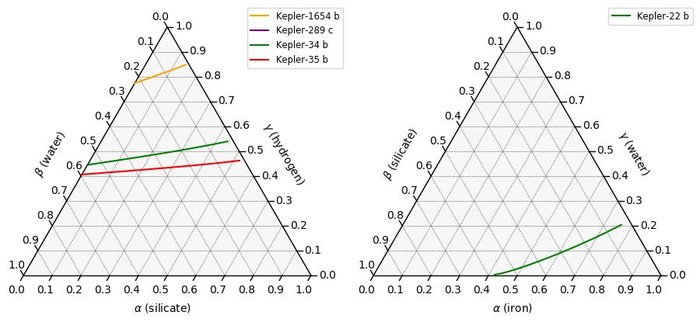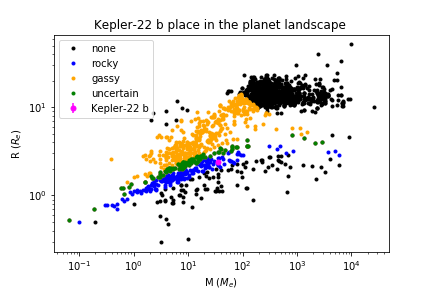Characterizing Exoplanet Interiors
We show that we are able to constrain the material composition of exoplanets given their mass and radius.
In the past couple of decades, we have discovered many new exoplanets in no small part due to the Kepler space telescope. Today, there are over 4000 known exoplanets. Determining the internal compositions of the exoplanets is of great scientific importance, however, exoplanets are too far away to send instruments to them, and many are also too far away to do accurate spectroscopy.
Building on the work of Seager et. al. 2007 and 2018, we show that it's possible to constrain the interior composition of exoplanets and classify the composition type from just the mass $M$ and radius $R$.
Methods
In order to constrain the interior composition, we must make some assumptions about the planets. Our model has 4 central assumptions:
- The planet's mass distribution is spherically symmetric.
- The planet is in hydrostatic equilibrium.
- The planet has a polytropic equation of state.
- The planet is differentiated.
Spherical symmetry
Spherical symmetry ensures that the density $\rho$ only depends on the radius. So the mass of a infinitely thin sphere shell at radius $r$ is given by
$$\frac{dm}{dr} = 4 \pi r^3 \rho(r).$$
We can get the total mass of the planet by integrating
$$M = \int_0^R 4 \pi r^3 \rho(r) dr .$$
Hydrostatic equilibrium
An object is in hydrostatic equilibrium, when the outward force from its pressure gradient $F_p$, is equal but opposite in magnitude to the gravitational force $F_g$. That is
$$F_p=-F_g$$
Gravity is based upon the mass of the planet. The pressure gradient is based on the pressure between the layers of mass in the planet, which results in a force, due to the pressure difference between the layers. We can the above equation to:
$$\frac{d P(r)}{d r}=-\frac{Gm(r)\rho(r)}{r^2}.$$
where $P(r)$ is the pressure at radius $r$, $G$ is the gravitational constant, $\rho(r)$, $m(r)$ are the density and mass of the planet respectively.
Equation of state
In general, we have an equation of state $P(r)=f(\rho(r),T(r))$ where $f$ is a function that depends on the material, and $T$ is the temperature. We neglect the temperature dependency, and we will also neglect phase changes since they have a little effect on the mass-radius relationship. The relationship between pressure ($p$) and density ($\rho$) for a compressible fluid can as such described by the Polytropic equation of state
$$p(\rho)=K\rho^\frac{n+1}{n}$$
Where $K,n$ are constants with $n$ being the polytropic index.
Taking these assumptions together, we get the Lane-Emden equation.
Since we are modelling the planets using materials such as iron, silicate and water, which are incompressible below certain pressures, the polytropic equation of state is a poor model for the relationship between density and pressure. We can extend the equation of state to approximately incorporate the model of the solids at low pressures by adding a constant $\rho_0$ term.
$$\rho (P) = \rho_0 + KP^{\frac{n+1}{n}}$$
where $\rho_0$ is the incompressible density. We will call this the modified polytropic equation of state.
Computer model
To model the planets we use the computer model developed by Zeng and Seager and translated to Python by Troels Haugbølle. The model assumes a 3-material differentiated planet where the planet is modeled as 3 shells that grow from the center with the most dense material closest to the center and becomes progressively less dense away from the center.
We denote the fractional compositions of the materials with $\alpha,\beta,\gamma$ where $\alpha$ is the fraction of the innermost material and $\gamma$ the fraction of the outermost material. We have that $1=\alpha+\beta+\gamma$. We have used materials that are found in planets and moons in our solar system: iron, silicate, water and hydrogen. For small earth-like planets we use a iron-silicate-water model, and silicate-water-hydrogen model for larger planets where the iron-silicate-water model is insufficient for reaching the large radii.
While we are inside the shell of a given material, the equation of state at that radius is modeled by the modified polytropic equation detailed for the given material. The equation of state gives the relationship between $\rho$ and $P$ such that we can solve the central system of coupled differential equations derived from spherical symmetry and hydrostatic equilibrium.
There are 5 parameters in this model ($\alpha, \beta, \gamma, M, R$), but since $\gamma=1-\alpha-\beta$, we only have 4 free parameters. From any $3$ of the them we can determine the whole system. However, since we only have measured the mass and radius of the planet and do not have more information from the gravitational moment or spectroscopy of the atmosphere, we cannot uniquely determine the system. Instead, we get a degeneracy. We get an infinite number of pairs of possible ($\alpha,\beta$). The computer model solves this numerically for a given $\alpha\in[0,1]$ by integrating the central equation starting at $r=R$ and stopping at $r=0$ using a 4th-order Runge-Kutta solver, and finds a $\beta$ which satisfies $M(0)<\epsilon$ for some small tolerance $\epsilon=10^{-5}$. It finds $\beta$ using bisection starting with the lower bound of $\beta_l=0$ and upper bound $\beta_u=1-\alpha$. Once we have a valid pair of ($\alpha,\beta$), we can find the associated $\gamma=1-\alpha-\beta$.
Analysis
We have performed a broad analysis using the entire NASA exoplanet archive (4367 planets) and then reducing the dataset to a more manageable size. In the first reduction, we required that the planets had measured radii and masses which are used for our analysis as well as measured star luminosity and distance to star. This reduced the dataset to 433 planets. After having identified a number of CHZ ranges we used the combined most relaxed range (LB: 0.725AU, UB: 1.24AU) which reduces the dataset further to 10 planets summarised below. Of these 10 planets there is one planet, Kepler-22 b, which we are able to model using the iron-silicate-water model while 4 others were classified using the silicate-water-hydrogen model.
| Name | Mass (M_e)(Me) | Radius (R_e)(Re) |
|---|---|---|
| Kepler-1514 b | 1700 | 12 |
| Kepler-1654 b | 160 | 9.1 |
| Kepler-22 b | 36 | 2.3 |
| Kepler-289 c | 130 | 12 |
| Kepler-34 b | 69 | 8.5 |
| Kepler-35 b | 40 | 8.1 |
| Kepler-47 c | 8900 | 4.6 |
| Kepler-62 e | 36 | 1.6 |
| Kepler-62 f | 35 | 1.4 |
| bet Pic b | 6400 | 17 |
We can plot the modelable planets in a ternary diagram as seen below. We note that Kepler-289 c doesn't show up. This is because given the resolution of the numerical solver, we only get one valid pair of $(\alpha,\beta)$. The planet has almost no silicate, and about 1% water while 99% of the mass is hydrogen.

We see that the Kepler-22 b planet stands out in particular.
Kepler-22 b
Kepler-22 b is an interesting planet. It is the only rocky planet in the habitable zone of its host star that we know of. Moreover, we find that it's possible that up to about 20% of its mass is water, but we don't know if the water on the surface is fluid, or a liquid, or perhaps a gas. We can estimate the surface temperature through the equilibrium temperature using Stefan-Boltzmann's law of black-body radiation.
$$L = 4\pi R_s^2 \sigma T_e^4$$
where $R_s$ is the radius of the star, and $T_e$ is the effective temperature. We can then figure out how much luminance hits the planet by multiplying by the fraction of the scaled-up sphere the earth-disc fills up.
$$L_p = L \frac{\pi R_p^2}{4\pi D^2}$$
where $D$ is the distance from the star to the planet, and $R_p$ is the radius of the planet.
By assuming both the planet and the host star are black-body radiators, we have that the incoming flux $L_p$ must be equal to the outcoming flux, so we can find the equilibrium temperature $T_{eq}$ of the planet by solving
$$L_p = 4\pi R_s^2 \sigma T_{eq}^4.$$
However, the planet is not a perfect black-body radiator, some of the light is reflected before it is absorbed. So assuming an Earth-like albedo, the equilibrium temperature, or the surface temperature is 262K which would mean the water would be a gas. However, that is assuming no atmosphere and greenhouse effect. If we model an Earth-like atmosphere and greenhouse effect - which is a lower-bound since the Kepler-22 b is much heavier than Earth which would give it a denser atmosphere - we get an equilibrium temperature of 287K which would give us liquid water. Which is consistent with other analyses.
While other analyses have been able to rule out an Earth-like composition for Kepler-22 b, we are not able to do so, as we would need the uncertainty in both the mass and the radius, but we do not have a lower-bound for the mass. This is common for planets which have been discovered using the transit-method. However, if we plot the approximately 2000 planets which have measured mass and radius, and classify then using our gas- and rocky models, we find that there is a lot of give before Kepler-22 b enters the "uncertain" region where it an be classified using both models.

Conclusion
We have seen that it is possible to constrain the interior composition of exoplanets from just the mass and the radius. Moreover, we are able to classify if the planets are rocky planets or have a gas layer. We looked at Kepler-22 b a rocky planet in the habitable zone and found that it is possible that there is liquid water on the planet which makes it interesting for people who are looking for extraterrestrial life.